Apple iPad mini with Retina Display: Reviewed
by Anand Lal Shimpi on November 16, 2013 8:00 AM ESTThe SoC
The iPad mini with Retina Display rounds out the three platforms that use Apple’s A7 SoC. Although both the iPad Air and iPhone 5S use the A7, the mini’s implementation is closer in nature to the iPhone. The iPad mini’s SoC has always used the same package-on-package (PoP) assembly as the iPhone, with DRAM stacked on top of the SoC itself (1GB in this case). The benefit is obviously a reduction in board area, the downsides have to do with cost and thermals. That’s the first similarity between the mini’s A7 and the iPhone’s A7.
The second is one of frequencies. While the iPad Air’s A7 runs its two Cyclone CPU cores at up to 1.4GHz, the SoC in the iPad mini and the iPhone 5S runs at up to 1.3GHz. That might sound like a minor difference, but it’s far more pronounced when you look at what happens to frequency when you’re running heavy workloads.
Once again I turn to a fairly heavy CPU workload to plot performance over time. This is a multithreaded workload, slightly modified from what we used in the iPad Air review, designed to make the CPU cores consume max power. The scale is linear and the workload is the same across all devices, so what you’re effectively looking at is a graph of thermally bound CPU performance over time across all three A7 implementations:
Being the largest device (and the only device with a metal heat spreader and no DRAM stacked on top), the iPad Air obviously maintains the highest frequencies for the duration of the test. The iPhone 5S, with a significant reduction in internal volume (and a PoP SoC) reduces its CPU frequencies early on in order to keep skin temperature down and properly manage thermals. The iPad mini with Retina Display falls between the two, with its performance curve more closely following that of the iPhone 5S.
Although the mini has a similar max operating frequency to the iPhone 5S, it is a faster device thanks to it being less thermally constrained. Similarly, the iPad Air can be much faster than its clock speed would otherwise imply. If you’re wondering why Apple has been so focused on building its own SoCs and CPU architectures, this is the reason why. There’s a fixed amount of power you can dissipate in the form of heat in these mobile devices while still maintaining a good user experience. Performance per watt is the gating metric for success in mobile, and shipping high IPC/low frequency dual-core SoCs at 32/28nm is the best optimization available to a company like Apple today.
As you’d expect, our browser based CPU tests show the mini’s A7 performing in between the iPhone 5S and iPad Air. None of these tests are anywhere near as stressful as our thermal test from above, so we don’t see exaggerated differences in performance between the platforms. For most, I suspect you won’t notice a huge performance difference between the mini and Air. Those who are heavier users (e.g. audio mixing, 3D gaming, etc…), there will be a performance difference between the two iPads.
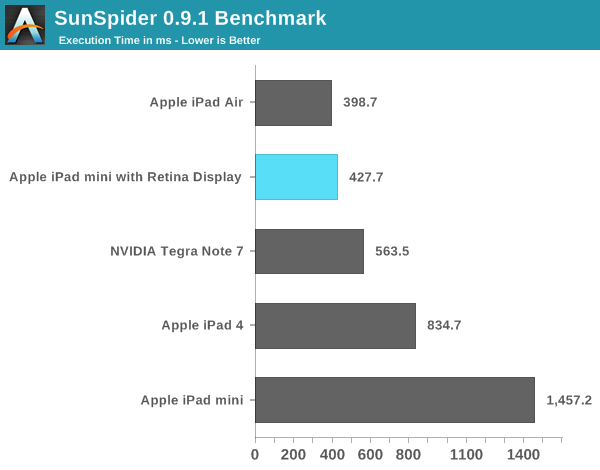

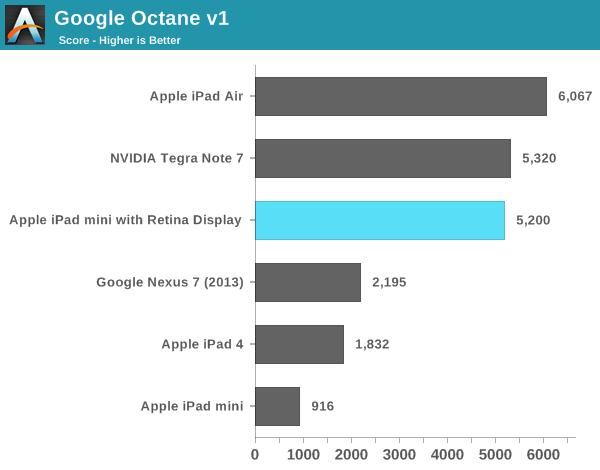
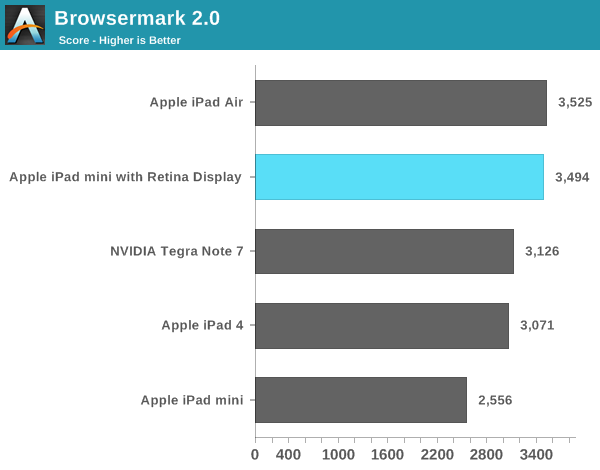
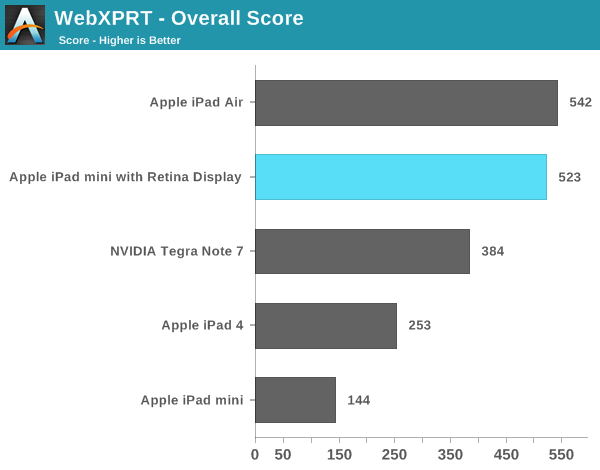
Compared to the first generation iPad mini, the new model is in a completely different performance league. Keep in mind the first mini used Apple’s A5 SoC based on an ARM Cortex A9. That’s the same single threaded performance as what’s in an iPhone 4S, and under iOS 7 it’s clearly running into some performance limits. The new mini with Retina Display however is a completely different animal. It’s fast.
Even comparing to the 4th generation iPad, the new mini is noticeably quicker.
Memory Bandwidth
Looking at the iPad mini’s memory bandwidth curve, we see it tracks very closely with that of the iPhone 5S. This is a slightly modified version of our previous bandwidth test, and you can see peak usable memory bandwidth (from the CPU’s perspective) of around 10GB/s. The ~12GB/s area right before you get out to main memory is bandwidth to the A7’s 4MB system-wide cache that sits after the shared L2 and the memory controller. This cache appears to service CPU, GPU and ISP requests at least.
GPU Performance
I believe the A7’s PowerVR G6430 GPU runs at around 450MHz. This frequency appears unchanged across all three A7 implementations. Once again, the big difference is how much thermal headroom exists in the platform which has an impact on overall performance.
Kishonti’s low level GPU performance tests back up my assertion that GPU frequency is fixed across all A7s. The iPad mini with Retina Display delivers equal performance to the iPad Air. The bigger news here is that nearly all of the GPU bound 3D tests seems to peg the mini and Air as equals. These are some pretty intense tests, but it looks like on the GPU side there’s no significant throttling when running at full tilt.
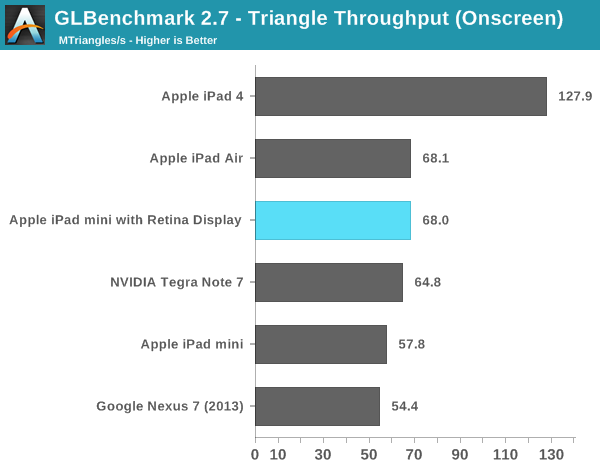

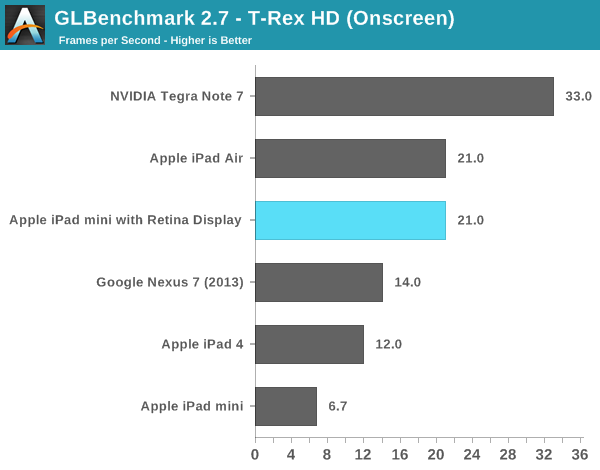

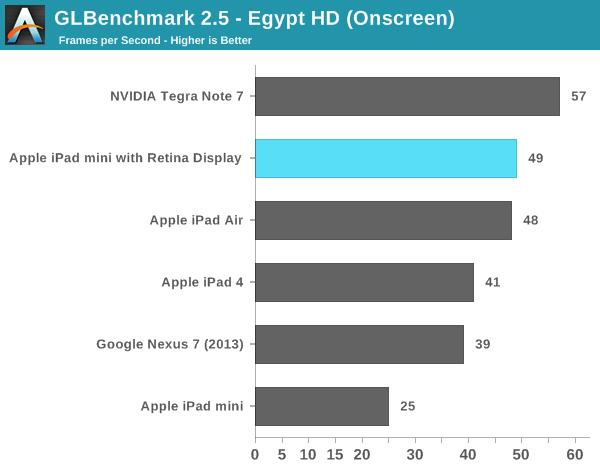
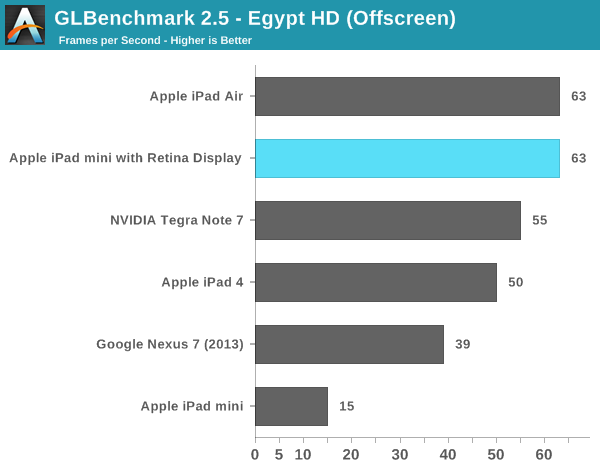
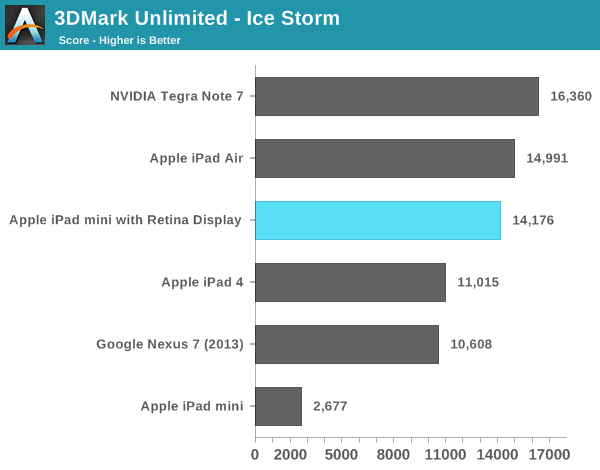
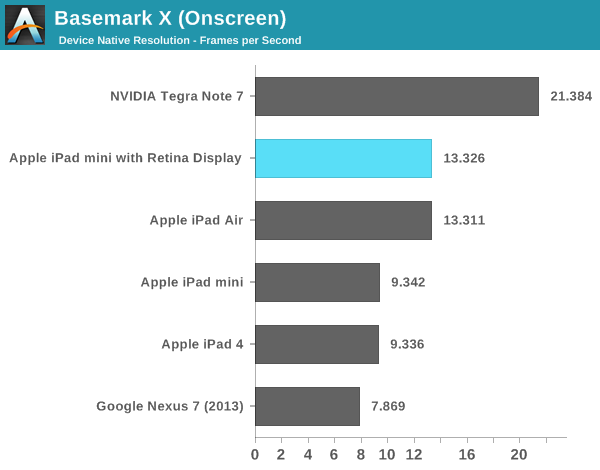
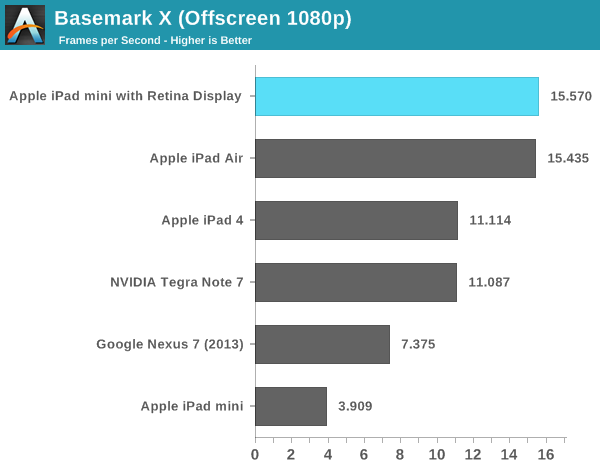
As I mentioned in our iPad Air review, despite having less peak theoretical memory bandwidth than the A5X/A6X, the A7 in the iPad mini never seems to regress in performance compared to even the iPad 4. Across the board the mini appears to be faster, more responsive and have more performance on tap than any prior iPad (big or small). The comparison to the original iPad mini is of course night and day. Even looking at lighter tests like the old GLBench Egypt HD benchmark, the iPad mini with Retina Display manages to be nearly twice as fast as the original mini - all while rendering 4x the number of pixels.


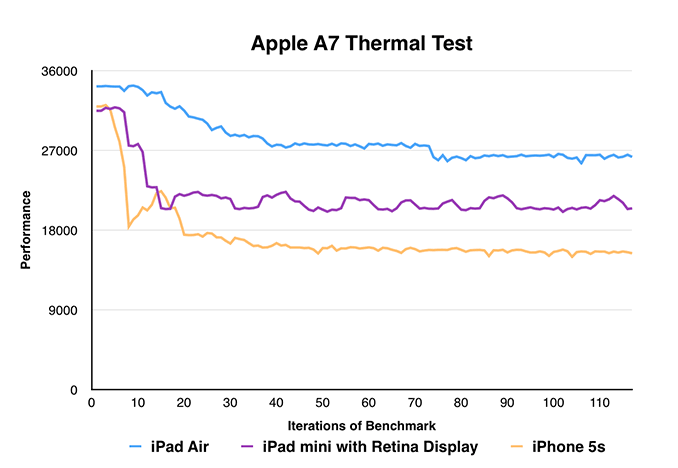
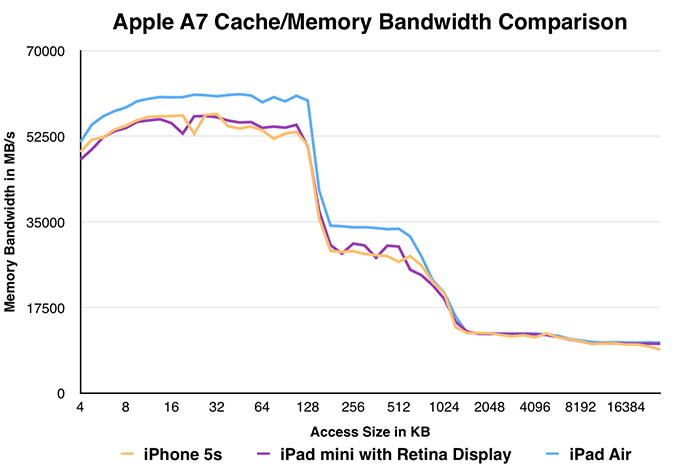








345 Comments
View All Comments
solipsism - Saturday, November 16, 2013 - link
Or you can save $100 by going with a smaller capacity device. Apple will make their margins regardless so what you're really saying is that they should 1) not make the iPad Mini only start at $299 and 2) they shouldn't even offer the lower capacity options because at $5 increments for doubling of capacity (laughable) it's only $15 between 16GB and 128GB.The fact is companies determine the entire line to figure how to maximize sales, margins and profits, not just an individual model, which is something you should understand even if you haven't taken a single economics course.
kyuu - Saturday, November 16, 2013 - link
Why the hell should the end consumer care about that? $100 for $5 worth of NAND is a rip-off. The end. Nobody cares about the ways in which Apple seeks to pad their already absurd profit margins.And yes, they could very well move their base model up to 32GB, like a lot of the rest of the market.
solipsism - Saturday, November 16, 2013 - link
The consumer (not sure why included the word "end" in there) should buy the product that best fits their needs. The consumer shouldn't say "Hey, cheap NAND is only $5 for 16GB so I shouldn't have to pay anymore for faster and/or reliable NAND that is included as part of a vendor's product."What you have done is foolishly expect that capacity should be sold to you at cost without any other consideration, the most egregious of which is thinking the price points should be defined by *you* and not the vendor.
People like you sicken me. You think it's up to you to dictate the terms of another company. You care nothing for the free market. You actually wrote, "Nobody cares about the ways in which Apple…" without once considering that Apple cares about their profits and that it's their product which gives the right to sell it as they see fit, yet instead of saying, "This isn't the product for me." you instead think they owe you something when they can't even keep them in stock.
It's their product and their price points. If you don't like it, don't buy it. It's really that simple.
Puberticus - Saturday, November 16, 2013 - link
Yep. You did it in a nutshell. The poor guy definitely needs a pinch.kwrzesien - Monday, November 18, 2013 - link
I think our perception of a premium product being obsolete because it fills up 16GB of NAND is important to Apple if they want to keep being a premium product. It not only frustrates users but it limits the sale of the content (apps/music/video) that consumes that space. Don't they want it to just work? Nevermind needing over 3GB free to update the OS.Daniel Egger - Saturday, November 16, 2013 - link
Why pay $3000 for a better engine in the car when the production costs are roughly the same?kyuu - Saturday, November 16, 2013 - link
I wouldn't. Generally, better engines do in fact cost more to produce, though, and generally there are more differences between two models of car than just their engine.RadarTheKat - Monday, November 18, 2013 - link
You are reading this wrong. Can you build a 128GB tablet in your garage with the quality of an iPad? Given that even global electronics vendors like Samsung, Asus, and others can't, I doubt you can either. So at $829, the top end iPad mini with retina display, 128GB of memory, and LTE connectivity.Start with that model, which is a computing miracle compared with anything the world could produce just three years ago, and then you'll see that Apple SAVES you $100 if you're willing to take that same miracle with half the memory. LOL!
Hey, but thanks for playing!
RadarTheKat - Monday, November 18, 2013 - link
* So at $829, the top end iPad mini with retina display, 128GB of memory, and LTE connectivity is a steal!Klug4Pres - Saturday, November 16, 2013 - link
1GB RAM for a 64-bit CPU of this calibre is also an insult, and will mean that this thing will choke on many workloads. It will also mean that come IOS 8 or 9, it will likely be unuseable. Oh well, just drop another $500 on a 2GB RAM, 32GB version next year.